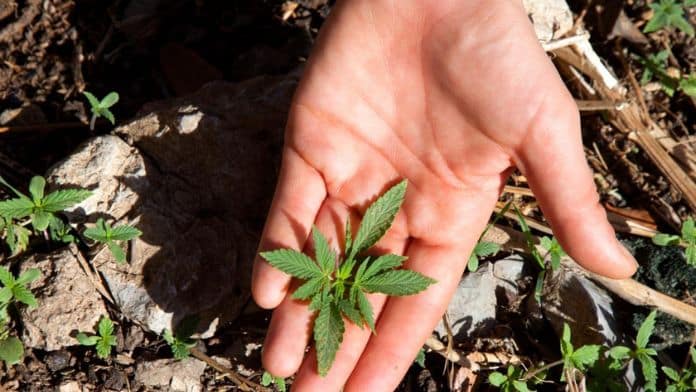Welcome to the enchanting world of “Cultivating Green Bliss: The Art and Joy of home grown weed.” Discover the secrets of growing your cannabis, transforming your home into a paradise of natural delight.
Growing weed journey goes beyond horticulture and encompasses the therapeutic and artistic aspects of caring for your cannabis plants.
Discover the joy of creating your variety, from seed to harvest, while enjoying the harmonious connection between nature and yourself.
Join us as we delve into the art and exhilaration of cultivating your green sanctuary, where each leaf tells a story of care, passion, and the pure joy of local happiness.
Basics of Home Growing

For home-growing basics, start with quality seeds or clones. Select a suitable developing medium, such as soil or hydroponics, and provide adequate light, typically using full-spectrum LEDs.
Maintain an optimal environment with adequate ventilation, temperature and humidity control. Water plants carefully, avoiding excess water.
Use nutrient-rich fertilizers to encourage healthy growth. Prune and train your home grown weed to optimize light exposure and airflow. Keep an eye out for pests and diseases and address problems promptly.
As your plants flower, move into the flowering stage by adjusting the light cycle. With diligence and patience, you’ll master the basics and grow your thriving garden.
Setting Up Your Home Grow Space

Select a suitable space: Choose an unobtrusive, well-ventilated area with ample space for your plants to thrive.
Lighting Essentials: Invest in quality grow lights, ensuring they meet the specific needs of your cannabis plants during different stages of growth.
Control the environment: Regulate temperature and humidity levels for optimal growth. Consider the use of fans and ventilation systems.
Choose the right medium: Select a nutrient-rich soil or a hydroponic system tailored to your growing preferences.
Nutrient Management: Provide a balanced nutrient regimen, adjusting it as your plants progress from seedling to flowering.
Security Measures: Implement safety measures to protect your home crop, keeping it discreet and safe.
Monitor and Adjust:
- Periodically check plant health.
- Adjust conditions accordingly.
- Keep an eye out for potential problems for a thriving home.
Germination and Seedling Care
In the realm of home grown weed cultivation, successful starts depend on meticulous germination and care of seedlings. Begin by gently placing the seeds in a moist medium, ensuring a cozy and warm environment to generate life.
Careful supervision is paramount during the germination phase, monitoring humidity levels and providing an enriching atmosphere.
As sprouts emerge, the delicate seedlings demand tender attention: optimal light, nutrient-rich soil, and a carefully regulated watering schedule. Protect them from stress and witness the first stages of your cannabis journey.
With dedicated germination and seedling care, you set the stage for a robust and prosperous harvest, laying the foundation for a bountiful harvest.
Vegetative Growth Stage
Optimal Lighting: Provide 18 to 24 hours of light per day to encourage robust growth.
Adequate Nutrients: Supply balanced nitrogen-rich nutrients for vigorous foliage development.
Ideal Temperature: Maintain temperatures between 70 and 85°F (21 and 29°C) for optimal growth.
Humidity Control: Maintain humidity levels between 40 and 60% to prevent mold and encourage leaf expansion.
Regular Pruning: Trim excess foliage to promote air circulation and focus energy on essential growth.
Training Techniques: Employ low-stress training (LST) or mulching to shape the plant and encourage lateral growth.
Hydration: Water generously, but ensure adequate drainage to avoid root problems.
Monitoring pH levels: Maintain pH levels between 6 and 7 for nutrient absorption.
Vigilant Pest Control: Inspect periodically for pests and remove them immediately to prevent damage.
Observation: Monitor plant health and adjust care based on individual strain characteristics.
Flowering Stage and Bud Development
During the flowering stage, cannabis plants undergo a remarkable transformation, going from foliage to bud development.
This Medical Cannabis crucial phase usually occurs between 7 and 9 weeks after growing and is marked by the appearance of vibrant, resinous flowers.
These home grown weed buds, rich in cannabinoids and terpenes, contain the key to the plant’s therapeutic potential.
As the flowers mature, the pistils change color, indicating maturity. Growers carefully control factors such as light, nutrients, and humidity to optimize bud growth.
Witnessing the intricate dance of pistils and trichomes, growers navigate the nuanced art of nurturing cannabis to its full potential, culminating in a harvest of potent, aromatic and visually stunning buds.
Nutrients and Feeding Schedule
Achieving optimal plant growth requires a meticulous approach to nutrients and a well-structured feeding program. Selecting the right balance of nitrogen, phosphorus and potassium is essential for vibrant, healthy plants.
Start with a high-nitrogen fertilizer during the vegetative stage to encourage robust foliage development, then transition to a phosphorus-rich formula when flowering begins, promoting robust bud formation.
Micronutrients such as iron, zinc, and magnesium are equally crucial for overall plant health. Establish a consistent feeding schedule, adjusting nutrient levels based on your Growing cannabis growth stage.
Monitor pH levels regularly to ensure nutrient absorption. Remember, the key to a thriving garden lies in understanding your plants’ nutritional needs and maintaining a disciplined feeding regimen.
Pest Control and Disease Management
Efficient pest control and disease management are crucial facets of maintaining a thriving agricultural or horticultural ecosystem.
These build a soil practices involve the strategic implementation of preventive measures and specific interventions to protect crops from harmful pests and diseases.
Integrated Pest Management (IPM) strategies aim to minimize chemical inputs, emphasizing biological controls, cultural practices and the careful use of pesticides when necessary.
Periodic monitoring, early detection and prompt response are essential to stop possible outbreaks. By adopting sustainable and holistic approaches, farmers and gardeners can foster resilient environments that mitigate the impact of pests and diseases, promoting the long-term health and productivity of their crops.
Harvesting and Curing
As your Homegrown Marijuana reach full potency, trim them carefully for optimal yield. Then, immerse yourself in the delicate art of curing, preserving flavor and potency. Mastering time and technique guarantees a top-quality final product.
- Harvest when trichomes are milky for maximum potency.
- Trim excess leaves for a clean aesthetic.
- Hang plants upside down in a dark, well-ventilated space.
- Maintain a temperature of 60 to 70°F (15 to 21°C) and humidity of about 50 to 60%.
- Let dry for 7 to 14 days until stems break, not bend.
- Begin curing in sealed jars, opening daily for the first two weeks.
- Cure for 4 to 8 weeks to improve flavor and softness.
- Store the cured buds in a cool, dark place, preserving the fruits of your meticulous harvest.
Conclusion
As we conclude our exploration of “Cultivating Green Bliss,” we celebrate the culmination of a profound journey. From seed to harvest, this odyssey transcends mere cultivation and encompasses a fusion of art, nature and personal joy.
Your homegrown weed is not just a product; It is a testament to patience, care and a harmonious connection with the land.
As you inhale the essence of their work, savor the unique symphony of flavors and revel in the joyful achievement of cultivating your green bliss – a sanctuary of pure, natural euphoria.
FAQ
Does homegrown weed smell?
It may seem obvious, but most hydroponic cannabis grows are discovered by passersby or discerning residents who catch the familiar smell of the drug.
What is homegrown marijuana?
Homegrown marijuana means marijuana grown by a person 21 years of age or older in that person’s place of residence for purposes not dependent on.

